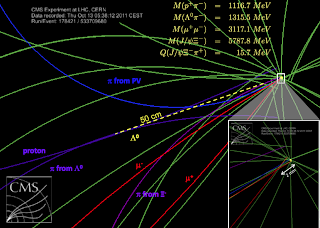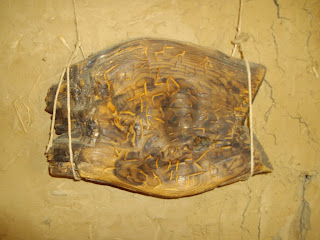LHC colpisce ancora: nuova particella scoperta al CERN.
Un nuovo barione, una particella composta da tre quark, è spuntato dal cilindro del Large Hadron Collider (LHC). La notizia è contenuta in un articolo inviato ieri alla rivista Physical Review Letters. Il nuovo barione, individuato da Claude Amsler, Vincenzo Chiochia e Ernest Aguiló (fisici dell'università di Zurigo) conferma alcune ipotesi formulate dalla fisica teorica e aiuta a comprendere l'interazione forte, una delle quattro forze fondamentali che determinano la struttura della materia come la conosciamo.
Insieme ai mesoni, particelle composte da un quark e un antiquark, i barioni costituiscono la famiglia degli adroni: non a caso la scoperta è avvenuta all'interno dell'esperimento CMS, dentro il grande acceleratore di adroni.
Observation of an excited Xi(b) baryon Submitted to Physical Review Letters on 26 Apr 2012 The observation of an excited b baryon via its strong decay into Xi(b)^- pi^+ (plus charge conjugates) is reported. The measurement uses a data sample of pp collisions at sqrt(s) = 7 TeV collected by the CMS experiment at the LHC, corresponding to an integrated luminosity of 5.3 inverse femtobarns. The known Xi(b)^- baryon is reconstructed via the decay chain Xi(b)^- to J/psi Xi^- to mu^+ mu^- Lambda^0 pi^-, with Lambda^0 to p pi^-. A peak is observed in the distribution of the difference between the mass of the Xi(b)^- pi^+ system and the sum of the masses of the Xi(b)^- and pi^+, with a significance exceeding five standard deviations. The mass difference of the peak is 14.84 +/- 0.74 (stat.) +/- 0.28 (syst.) MeV. The new state most likely corresponds to the Xi(b)^{*0} baryon, the J^P=3/2^+ excitation of the Xi(b)^0.
Questo è l'articolo originale:
Observation of an excited Xi(b) baryon Submitted to Physical Review Letters on 26 Apr 2012 The observation of an excited b baryon via its strong decay into Xi(b)^- pi^+ (plus charge conjugates) is reported. The measurement uses a data sample of pp collisions at sqrt(s) = 7 TeV collected by the CMS experiment at the LHC, corresponding to an integrated luminosity of 5.3 inverse femtobarns. The known Xi(b)^- baryon is reconstructed via the decay chain Xi(b)^- to J/psi Xi^- to mu^+ mu^- Lambda^0 pi^-, with Lambda^0 to p pi^-. A peak is observed in the distribution of the difference between the mass of the Xi(b)^- pi^+ system and the sum of the masses of the Xi(b)^- and pi^+, with a significance exceeding five standard deviations. The mass difference of the peak is 14.84 +/- 0.74 (stat.) +/- 0.28 (syst.) MeV. The new state most likely corresponds to the Xi(b)^{*0} baryon, the J^P=3/2^+ excitation of the Xi(b)^0.
Questo è il comunicato ufficiale: Observation of a new Xi_b^*0 beauty particle The CMS experiment has submitted a paper for publication describing the first observation of a new, excited beauty baryon known as the Ξ*b0
The observation was made in a data sample of proton—proton collisions delivered in 2011 by CERN's Large Hadron Collider (LHC) operating at a
centre-of-mass energy of 7 TeV.





Commenti